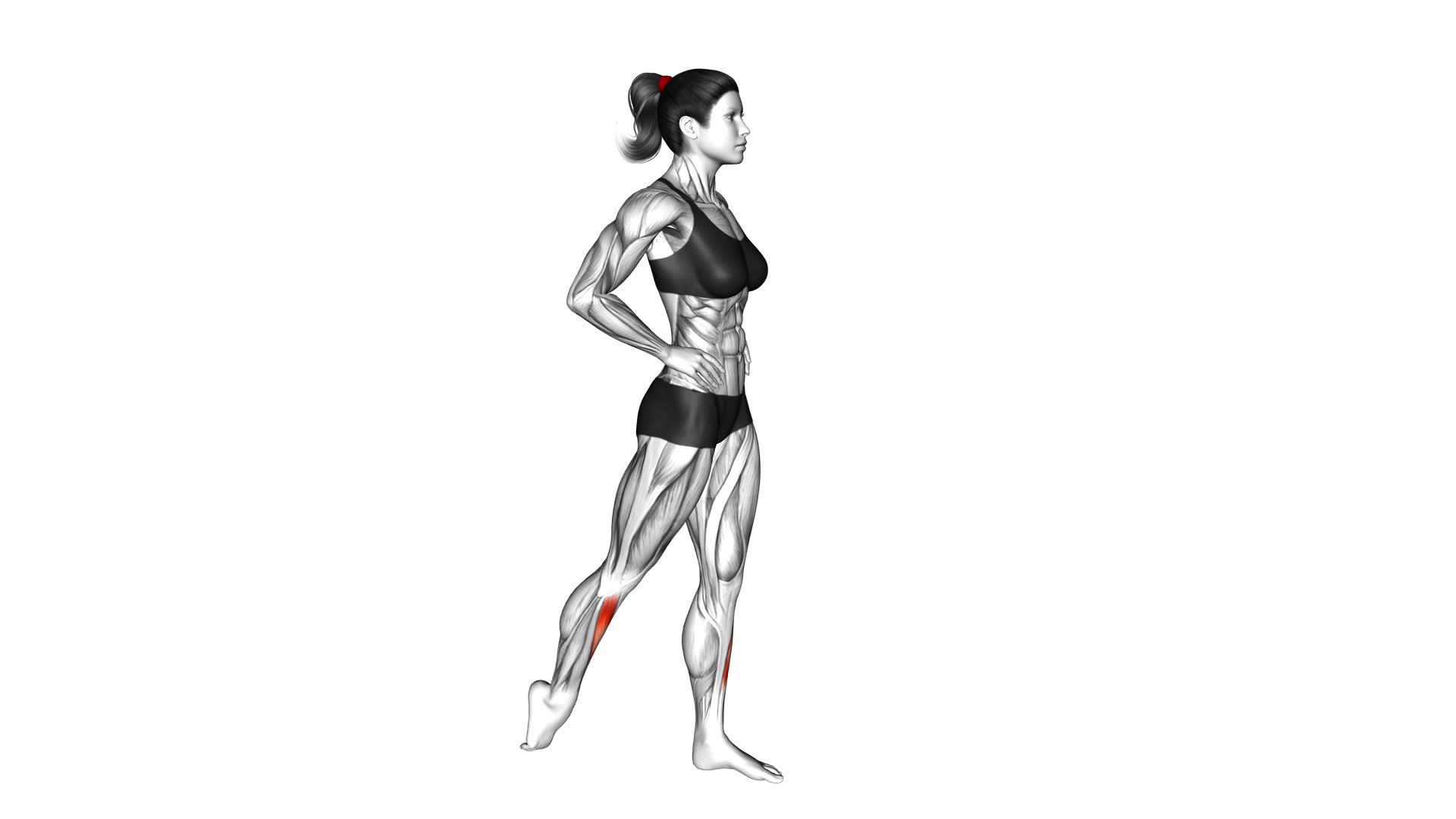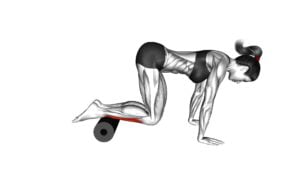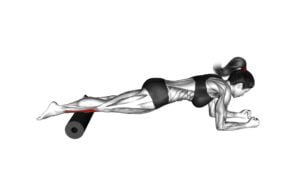Standing Tibialis Anterior Stretch (female) – Video Exercise Guide & Tips

Are you looking to improve your flexibility and relieve tension in your lower legs? Look no further than the standing tibialis anterior stretch.
Watch This Exercise Video
This exercise targets the muscles on the front of your shins, helping to prevent shin splints and improve your overall mobility. In this video exercise guide, we'll show you the proper form and technique, as well as provide helpful tips to maximize your stretch.
Get ready to feel the benefits and take your leg workout to the next level.
Key Takeaways
- The Standing Tibialis Anterior Stretch improves flexibility in the lower legs and relieves tension.
- It helps prevent shin splints and enhances overall mobility.
- The exercise can be modified using props, resistance bands, and different foot positions for varying intensity.
- Proper form and technique, along with injury prevention techniques, should be followed to maximize the stretch and prevent injuries.
Benefits of the Standing Tibialis Anterior Stretch
What are the benefits of performing the Standing Tibialis Anterior Stretch?
The Standing Tibialis Anterior Stretch offers a host of benefits that can greatly enhance your overall lower body flexibility and strength. This stretch specifically targets the tibialis anterior, a muscle located in the front of your lower leg.
By incorporating this stretch into your routine, you can improve your ankle mobility and stability, which is crucial for activities such as walking, running, and jumping. Additionally, this stretch helps to prevent common lower leg injuries, such as shin splints.
The technique for performing the Standing Tibialis Anterior Stretch is relatively simple. Start by standing upright, then extend one leg straight in front of you while keeping the foot flexed. Place your hands on a stable surface for support and gently lean forward, feeling the stretch in the front of your lower leg.
Hold the stretch for 20-30 seconds and repeat on the other leg. By regularly practicing this stretch, you can reap the benefits of increased lower body flexibility, improved ankle mobility, and reduced risk of lower leg injuries.
Equipment Needed for the Exercise
To perform the Standing Tibialis Anterior Stretch, you'll need minimal equipment. This exercise primarily focuses on stretching the tibialis anterior muscle, which is located in the front of your lower leg. The equipment needed for this stretch includes a sturdy wall or a stable object to support your balance. You may also want to have a mat or towel to provide some padding for your knees if you prefer.
Modifications and variations can be made to accommodate different fitness levels or preferences. If you have difficulty balancing, you can perform the stretch while sitting on a chair or stool, with your foot extended in front of you. This will reduce the amount of weight bearing on your leg.
Alternatively, if you want to increase the intensity of the stretch, you can use a resistance band. Wrap the band around the top of your foot and hold onto the other end. As you lean forward into the stretch, the band will provide additional resistance, further stretching the tibialis anterior muscle.
Remember to always listen to your body and adjust the exercise according to your comfort level. It's important to perform the Standing Tibialis Anterior Stretch correctly to avoid any potential injury.
Proper Form and Technique
To perform the Standing Tibialis Anterior Stretch with proper form and technique, it's important to focus on body alignment and positioning. Keep your back straight, shoulders relaxed, and engage your core muscles.
Avoid common mistakes such as leaning forward or hunching your shoulders, as this can compromise the effectiveness of the stretch. By maintaining proper form, you can effectively target and stretch the Tibialis Anterior muscle.
Body Alignment and Positioning
Maintaining proper body alignment and positioning is crucial when performing the Standing Tibialis Anterior Stretch (female), ensuring optimal form and technique. Correct body mechanics and postural alignment are essential to prevent strain or injury to the muscles and joints involved in this stretch.
To achieve proper alignment, start by standing tall with your feet hip-width apart. Keep your shoulders relaxed and your chest lifted. Engage your core muscles to stabilize your spine and pelvis.
As you lift one foot off the ground, maintain a neutral spine and avoid leaning forward or backward. Keep your standing leg slightly bent and your knee aligned with your toes. This alignment will help target the tibialis anterior muscle effectively and enhance the benefits of the stretch.
Avoiding Common Mistakes
To ensure proper form and technique, you should avoid common mistakes when performing the Standing Tibialis Anterior Stretch (female). By avoiding these mistakes, you can prevent injuries and improve flexibility.
One common mistake isn't maintaining proper body alignment and positioning. It's important to stand tall with your feet hip-width apart and your knees slightly bent.
Another mistake to avoid isn't engaging your core muscles. By keeping your core activated, you can stabilize your body and maintain balance during the stretch.
Additionally, make sure to avoid applying excessive pressure or force on the stretch. Instead, focus on gradually increasing the intensity of the stretch over time.
By being mindful of these common mistakes, you can perform the Standing Tibialis Anterior Stretch (female) safely and effectively.
Now, let's move on to discussing modifications and variations.
Modifications and Variations
You can easily modify and vary the Standing Tibialis Anterior Stretch to suit your individual needs and preferences. There are several modification options and advanced variations that you can try to enhance the effectiveness of this stretch.
To modify the Standing Tibialis Anterior Stretch, you can use a prop such as a yoga block or a rolled-up towel to support your foot. This can help alleviate any discomfort or strain on your ankle or foot. Additionally, you can adjust the distance between your feet to increase or decrease the intensity of the stretch. Bringing your feet closer together will provide a milder stretch, while spreading them farther apart will intensify the stretch.
For those looking for advanced variations, you can incorporate ankle weights or resistance bands into the stretch. Ankle weights can add resistance, making the stretch more challenging and engaging the muscles even further. Resistance bands can be used to provide a deeper stretch by applying gentle pressure on the foot and ankle.
Remember to listen to your body and only go as far as feels comfortable for you. It's important to maintain good form and avoid any pain or discomfort.
Common Mistakes to Avoid
When performing the Standing Tibialis Anterior Stretch, it's important to pay attention to proper form demonstration and incorporate injury prevention techniques.
By maintaining the correct form, you can effectively target and stretch the tibialis anterior muscle without risking injury.
Additionally, implementing injury prevention techniques such as gradual progression and listening to your body's limits can help you avoid common mistakes and maximize the benefits of the exercise.
Proper Form Demonstration
Avoid these common mistakes when performing the standing tibialis anterior stretch to ensure proper form. Proper form is essential to maximize the benefits of this stretch and prevent injury.
- To begin, make sure you're standing with your feet hip-width apart and your toes pointing forward.
- Avoid locking your knees and keep a slight bend in them throughout the stretch.
- As you lean forward, keep your back straight and engage your core for stability.
- Be sure to avoid rounding your shoulders or hunching over.
To modify the stretch, you can use a wall or a chair for support. For variations, you can try performing the stretch with one foot at a time or while seated.
Remember to listen to your body and adjust the intensity as needed.
Injury Prevention Techniques
To prevent injuries, it's important to be mindful of common mistakes that can occur while performing the standing tibialis anterior stretch. Here are some injury prevention techniques to help you maximize the stretch and reduce the risk of injury:
- Warm up properly: Before attempting any stretching exercises, make sure to warm up your muscles with light cardio exercises or dynamic stretches. This will increase blood flow to the muscles and prepare them for the stretch.
- Use proper form: Maintain a good posture throughout the stretch, keeping your back straight and shoulders relaxed. Avoid rounding your back or leaning forward, as this can put unnecessary strain on the lower back.
- Gradually increase intensity: Start with a gentle stretch and gradually increase the intensity over time. Avoid pushing yourself too hard too soon, as this can lead to muscle strains or tears.
- Listen to your body: Pay attention to any pain or discomfort during the stretch. If you feel any sharp or intense pain, stop immediately and consult a healthcare professional.
Tips for Maximizing the Stretch
Maximize the stretch by focusing on maintaining proper form and engaging the muscles throughout the exercise. To maximize flexibility and get the most out of your standing tibialis anterior stretch, it's important to follow proper stretching techniques. Here are some tips to help you get the most out of this exercise.
Firstly, make sure to stand with your feet shoulder-width apart and keep your back straight. This will help stabilize your body and ensure that you're targeting the right muscles.
Next, engage your core and activate your tibialis anterior muscle by pulling your toes up towards your shins. This will enhance the stretch on the front of your lower leg.
As you perform the stretch, remember to breathe deeply and relax into the position. Avoid bouncing or jerking movements, as these can lead to injury. Instead, gently increase the stretch by leaning forward slightly and pushing your hips back. You should feel a moderate tension in your tibialis anterior muscle, but never push yourself to the point of pain.
To maximize the stretch, hold the position for 20 to 30 seconds, and then release. Repeat the stretch on both legs for a balanced workout. By maintaining proper form and engaging your muscles throughout the exercise, you can maximize the benefits of the standing tibialis anterior stretch and improve your flexibility over time.
Frequently Asked Questions
How Often Should I Perform the Standing Tibialis Anterior Stretch?
To maximize the effectiveness of the standing tibialis anterior stretch, it's important to consider the frequency of performing it. The frequency will depend on your specific goals and needs.
It's generally recommended to perform this stretch at least 2-3 times per week. However, consulting with a fitness professional or trainer can help determine the most appropriate frequency for you.
Remember to listen to your body and adjust the frequency as needed.
Can This Stretch Help With Shin Splints?
Yes, the standing tibialis anterior stretch can be helpful in treating shin splints. By stretching the tibialis anterior muscle, which is located in the front of your shin, you can alleviate some of the pain and discomfort associated with shin splints.
However, it's important to note that this stretch is just one of many potential treatments for shin splints. There are also alternative stretches and exercises that can target the affected area and provide relief.
Is It Necessary to Warm up Before Doing This Exercise?
Before engaging in the Standing Tibialis Anterior Stretch, warming up is highly recommended. It helps prepare your muscles and joints for the exercise, reducing the risk of injury. Warming up increases blood flow, which improves flexibility and range of motion. Additionally, it enhances performance by activating your muscles and improving coordination.
When performing the stretch, be cautious of common mistakes such as hunching your back or applying excessive force. Proper form and technique are essential for maximizing the benefits of this exercise.
Can I Do This Stretch if I Have Ankle or Foot Injuries?
If you have an injured ankle or foot injuries, it's important to be cautious when stretching. Before attempting the Standing Tibialis Anterior Stretch, consult with a healthcare professional to ensure it's safe for you.
They can provide guidance on modifications or alternate stretches that may be more suitable for your condition. Remember, the goal is to promote healing and prevent further injury, so always prioritize your health and follow professional advice.
How Long Should I Hold the Stretch for Maximum Benefit?
To get the maximum benefit from the standing tibialis anterior stretch, it's important to know how to properly perform it.
Begin by placing one foot behind you, with the toes pointing forward.
Shift your weight onto the front foot and gently lean forward, feeling a stretch in the front of the ankle.
Hold this stretch for about 30 seconds to one minute.
Beginners can start with a shorter duration and gradually increase it as they feel comfortable.
Conclusion
In conclusion, the standing tibialis anterior stretch is a beneficial exercise for stretching and strengthening the muscles in the front of the lower leg.
By following proper form and technique, using the necessary equipment, and avoiding common mistakes, you can maximize the effectiveness of this stretch.
Remember to consult with a healthcare professional before starting any new exercise routine, especially if you have any existing medical conditions or injuries.
Keep practicing and enjoy the benefits of a flexible and strong tibialis anterior muscle.

Author
Years ago, the spark of my life’s passion ignited in my mind the moment I stepped into the local gym for the first time. The inaugural bead of perspiration, the initial endeavor, the very first surge of endorphins, and a sense of pride that washed over me post-workout marked the beginning of my deep-seated interest in strength sports, fitness, and sports nutrition. This very curiosity blossomed rapidly into a profound fascination, propelling me to earn a Master’s degree in Physical Education from the Academy of Physical Education in Krakow, followed by a Sports Manager diploma from the Jagiellonian University. My journey of growth led me to gain more specialized qualifications, such as being a certified personal trainer with a focus on sports dietetics, a lifeguard, and an instructor for wellness and corrective gymnastics. Theoretical knowledge paired seamlessly with practical experience, reinforcing my belief that the transformation of individuals under my guidance was also a reflection of my personal growth. This belief holds true even today. Each day, I strive to push the boundaries and explore new realms. These realms gently elevate me to greater heights. The unique combination of passion for my field and the continuous quest for growth fuels my drive to break new ground.







